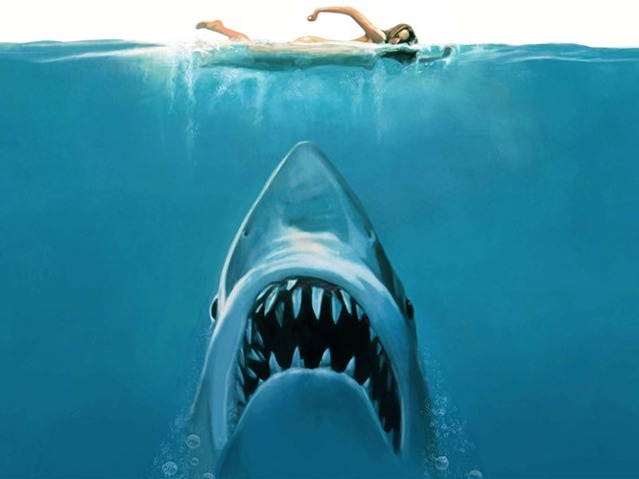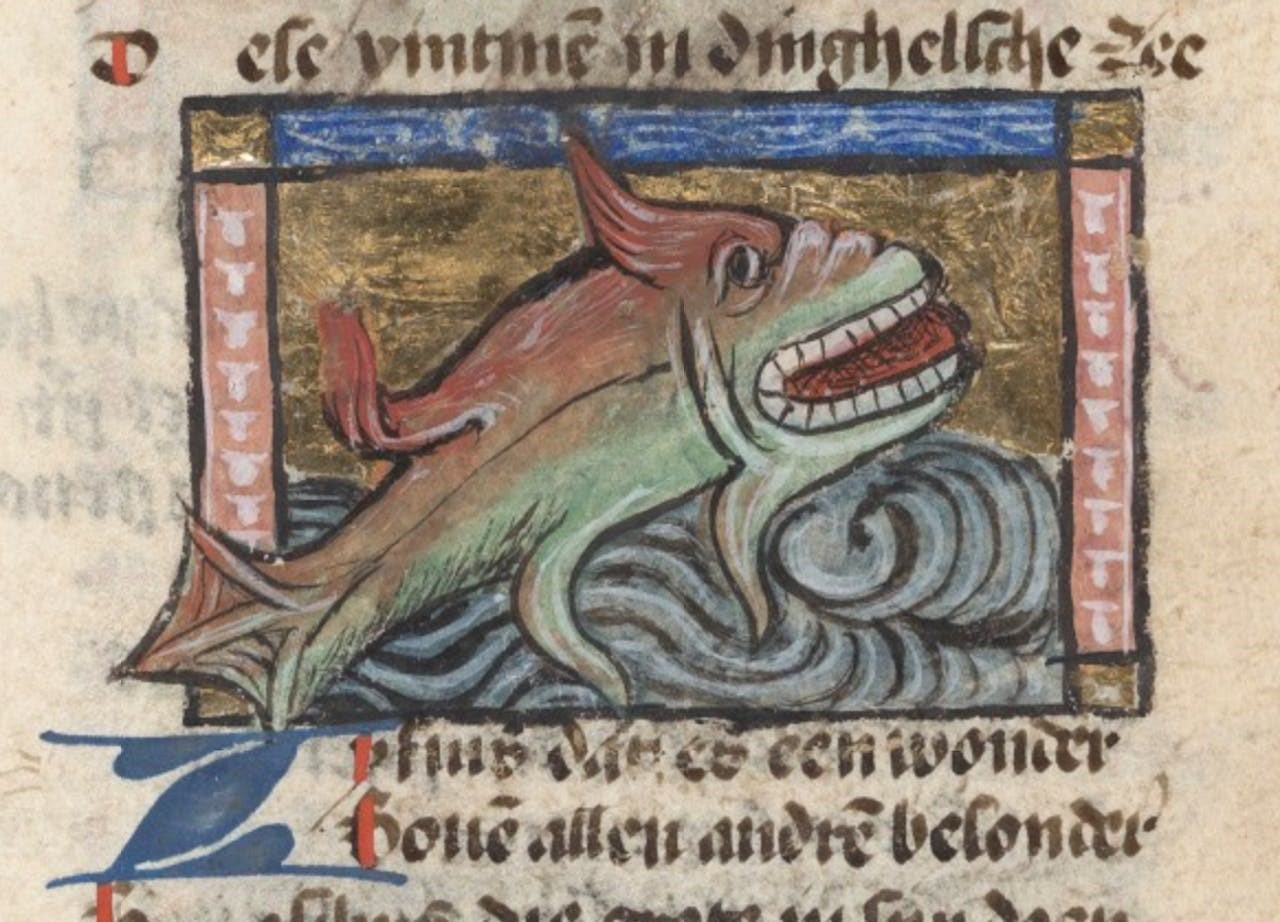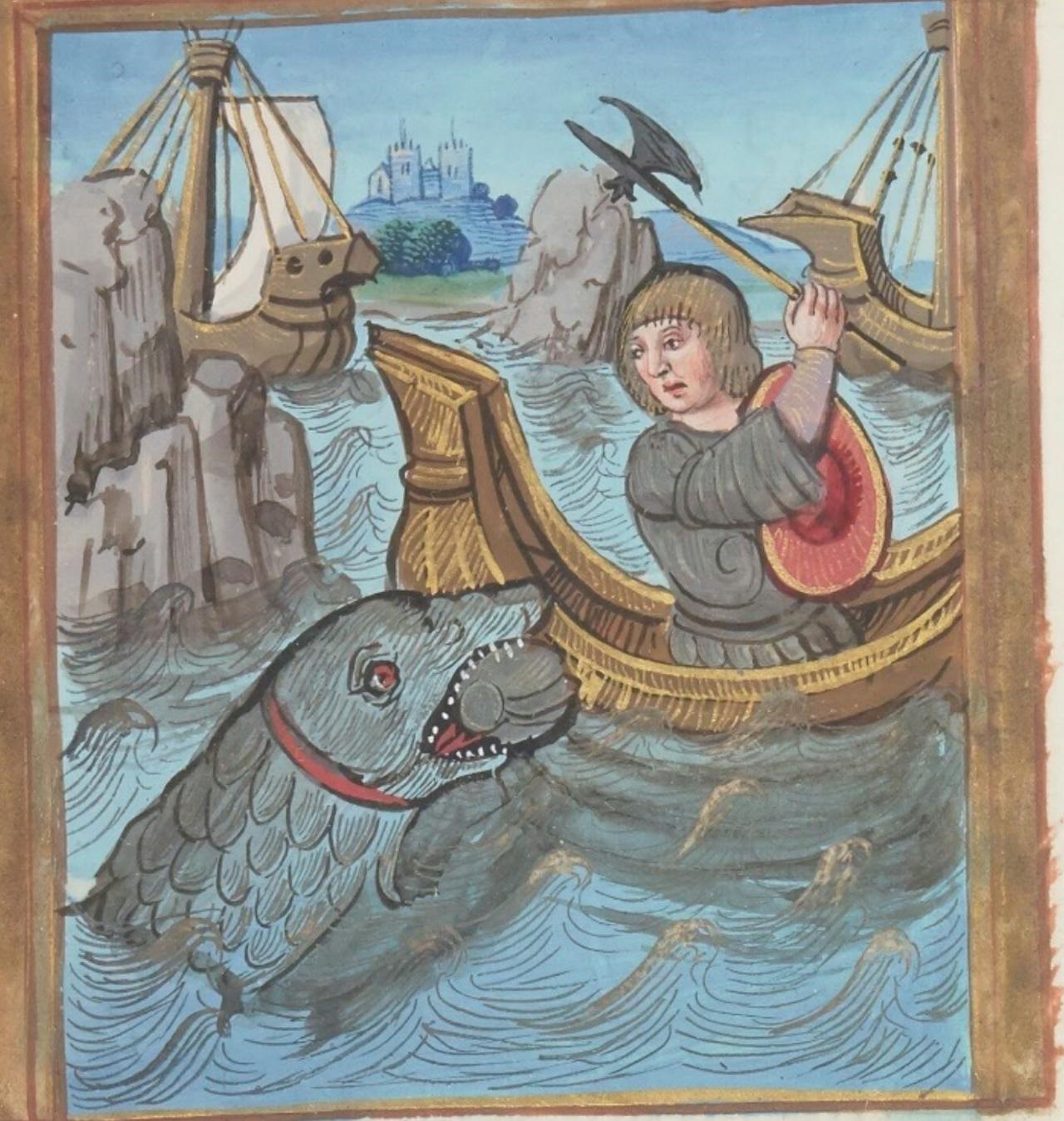50th Anniversary of Jaws: “Man’s deepest fear has risen again”

Jaws, Steven Spielberg’s iconic creature feature, celebrates its 50th anniversary on June 20th. ‘Bruce,’ the monstrous great white shark that terrorises the island of Amity in the film Jaws, inspired many horror films about bloodthirsty fish over the years, ranging from huge (The Meg) to small (Piranha 3D) to… flying (Sharknado). However, most sharks don’t pose a danger to humans – especially not at crowded beaches. Where does this deep-seated fear for sharks come from? Let’s take a small dive into cultural heritage about sea monsters.
Timeless sea monster
Oceans and seas remain, despite our best attempts, difficult to truly fathom. Horror films like Jaws play with thalassophobia, the fear of the unknown that lurks underneath the water surface. Often, the threat slumbers somewhere in the deeps and it attacks at night. To restore order, the monster usually has to be killed, preferably via a dramatic confrontation in the open sea so our film heroes are forced to rely on nothing but their wits – and a great portion of luck.
Over 439 million years ago, before there were dinosaurs or even trees, sharks already swam around in the deep. Aristotle described the reproductive behaviour of the dog shark already with a degree of precision that shark experts would not achieve again until 1820. Other sources from the antiquity suggest that there was no lack of sea monsters (including probably sharks) in the Mediterranean Sea: Herodotus, for instance, recounts that over 20,000 shipwrecked people were devoured by sea monsters in 492 BCE.
In medieval bestiaries, several fish species are named that could refer to sharks. With his – in the words of Jacob van Maerlant – terrible jaws, ‘like the mouth of hell,’ his great size and distinctive fins, the Zyphius displays many similarities to the great white shark. Jacob also refers to the ‘seehont’ (Canis marinus, or ‘sea dog’ – probably the dog shark again), a great fish, ‘dreadful in fury and hostility.’ Clearly, the sea dog here has nothing to do with the cute seal to which the term zeehond refers in modern Dutch.
We also see in Lion de Bourges, a fifteenth-century knight’s tale, how a ‘devilish spirit in the shape of a fish’ wrecks over 80 ships and manages to withstand our hero, Lion. Only God’s intervention via his loyal servant, the White Knight, is able to vanquish the monster.
Bloodthirsty killing machine
Sharks have often been characterised as utterly inhuman and lethally intelligent monsters. Likewise in Jaws:
“What we are dealing with here is a perfect engine, an eating machine. It’s really a miracle of evolution. All this machine does is swim and eat and make little sharks, and that’s all.”
The sinister quality of Bruce – like that of creatures such as the xenomorph from Alien or the velociraptors from Jurassic Park, is that they are too ‘machinelike’ for harmonious coexistence. They are, in other words, physically superior, ingenious, and above all unrelenting, pitiless hunters. The brutality with which they ‘slaughter’ people makes a mockery of the common assumption that humans exist at the top of the food chain. When Bruce tears a beachgoer to pieces, he essentially reduces this person to a lump of meat in a bikini. This triggers a very primal kind of fear: our reason, which we have prided ourselves on since Aristotle’s time, is of little consequence when we are outmatched by the instincts of a more intelligent, stronger predator.
Yet great white sharks are no irrational (killing) machines: they are curious fish with a complex social life. Although they are solitary hunters, they prefer using rituals and performative displays instead of violence to resolve conflicts. Their bite is often not intended to kill but to explore: after all, they don’t have limbs to calmly touch something that they can’t identify by sight or scent. The bite of a confused shark can still cause great harm to humans, but this is exceptional. You can easily avoid a shark bite by not swimming in shark territory or murky sea water.
Persistent reputation
According to the International Shark Attack File (ISAF), an overview of shark attacks worldwide, there were only 47 attacks in 2024 on humans who did not provoke the attack themselves. By comparison: mosquitoes annually cause over one million deaths. Thus, when you go on a beach holiday, you have more to fear from a mosquito bite than from a shark.
Still, sharks suffer from an abiding image problem. Although they have managed to swim right through all extinction events so far, the global number of sharks has halved since the 1970s. This is largely due to overfishing, but also due to ‘sharking’ (the hunt for sharks), often encouraged by the culture of anxiety fed by the cultural impact of Jaws over the last 50 years (something for which Steven Spielberg expressed his regret in a 2022 BBC radio interview).
The notion that sharks develop a preference for humans once they have tasted human meat (a claim that has also been made about wolves since the Middle Ages) is not grounded in fact. We are actually too bony and insufficiently nutritious for them.
Still, the myth of the bloodthirsty shark continues to pervade popular culture through films and games alike. In video games like Jaws Unleashed (2006) and Maneater (2021), players can inhabit the body of a monstrous shark and turn touristy beaches into bloodbaths in the most gruesome ways. Bruce and his dead-eyed descendants in our popular culture ultimately teach us little about how real sharks experience the world. Instead, the dark water surface of all shark horror only reflects one image: our own.
Sven Gins is a PhD Researcher at the Faculty of Religion, Culture and Society. This blog was originally published in Dutch on NEMO Kennislink, where he is a Face of Science.



